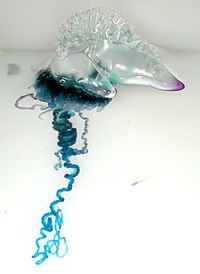
Photo from wikipedia
Potassium‐ion batteries have emerged not only as low‐cost alternatives to lithium‐ion batteries, but also as high‐voltage energy storage systems. However, their development is still encumbered by the scarcity of high‐performance… Click to show full abstract
Potassium‐ion batteries have emerged not only as low‐cost alternatives to lithium‐ion batteries, but also as high‐voltage energy storage systems. However, their development is still encumbered by the scarcity of high‐performance electrode materials that can endure successive potassium‐ion uptake. Herein, a hydrated Bi‐Ti bimetallic ethylene glycol (H‐Bi‐Ti‐EG) compound is reported as a new high‐capacity and stable anode material for potassium storage. H‐Bi‐Ti‐EG possesses a long‐range disordered layered framework, which helps to facilitate electrolyte ingress into the entire Bi nanoparticles. A suite of spectroscopic analyses reveals the in situ formation Bi nanoparticles within the organic polymer matrix, which can alleviate stresses caused by the huge volume expansion/contraction during deep cycles, thereby maintaining the superior structural integrity of H‐Bi‐Ti‐EG organic anode. As expected, H‐Bi‐Ti‐EG anode exhibits a high capacity and superior long‐term cycling stability. Importantly for potassium storage, it can be cycled at current densities of 0.1, 0.5, 1, and 2 Ag−1 for 800, 700, 1000, and even 6000 cycles, retaining charging capacities of 361, 206, 185, and 85.8 mAh g−1, respectively. The scalable synthetic method along with the outstanding electrochemical performance of hydrated Bi‐Ti‐EG, which is superior to other reported Bi‐based anode materials, places it as a promising anode material for high‐performance potassium storage.
Journal Title: Advanced Functional Materials
Year Published: 2023
Link to full text (if available)
Share on Social Media: Sign Up to like & get
recommendations!